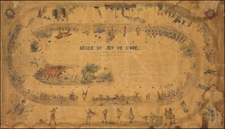Japanese Newspaper Broadside Showing the Arrival of Commodore Perry's Ships
Woodcut-printed Kawaraban showing cannons emanating from the hull of an American "black ship" of the sort used by Commodore Perry. The ship is imposingly depicted, with high masts, a hellish steam wheel, and numerous canons.
The arrival of Perry into Japan was a turning point for the nation's history, as it forced the country to abandon its traditional isolationist policies and open itself to western trade. Perry's men, and the black ships they sailed, were a center of attention for late Edo Period Japan.
Kawarabans (literally, "roof tile prints") are broadside newspaper prints that were distributed across Japan and told of major events, such as natural disasters and changes of political regime. According to Tatsuzou Tomizawa, they are characterized by five major points: newsworthy content; commercial availability; printed soon after the event; illegally published without government authorization; published anonymously. The arrival of Perry's ships was such a major event that it generated its own type of kawaraban, "kurofune [black ships] kawaraban." This present image is an example of a kurofune kawaraban.
Japanese newspapers began in the 17th century as yomiuri (読売、literally "to read and sell") or kawaraban (瓦版, literally "tile-block printing" referring to the use of clay printing blocks), which were printed handbills sold in major cities to commemorate major social gatherings or events. These sheets were often printed anonymously.
The kawaraban publishers served as a crucial vector for the transmission of information about Commodore Mathew Perry's opening of Japan. During the Edo Period, the arriving European vessels were called kurofune (Black Ships). That time was characterized by great social upheaval, and intense public interest in the agents of the outside world arriving in Japan.
Anna Wada, in "About Kawaraban", Perry in Japan A Visual History, gives background on the kawaraban:
The kawaraban took up a range of topics, including natural disasters, superstitious happenings, murders, and less commonly, political satire. Printers chose topics more to entertain and satisfy the readers’ curiosity than to educate them. Visual components such as illustrations, diagrams, and maps attracted the people to the print and helped them to understand the text, as well as sometimes offering additional information.
Throughout the Edo period the shogunate repeatedly restricted printing for a mass audience, particularly seeking to avoid rumors and political commentary. By the time the Black Ships [i.e., Perry’s fleet] arrived at the end of the Edo period, however, the system of censorship could not keep up with the number of prints in circulation. The increase in publications coincided with the spread of literacy in both urban and rural areas.









![[Santa's Telegram]](https://storage.googleapis.com/raremaps/img/small/68586.jpg)
![[Japan] Carte Des Decouvertes au Nord du Japon Faites en 1643 par les Vaisseaux Hollandais le Kastrkum et le Breskens, Comprenant la Terre de Jeso, I'Ile des Etats et la Terre de Compagnie, dont partie a ete reconnue en 1787 . . .](https://storage.googleapis.com/raremaps/img/small/49803.jpg)

![[The First Maps Printed Color] Cartes en Couleur des Lieux Sujets aux tremblements de Terre Dans toutes les parties du Monde Selon le Sisteme de l’impulsion Solaire](https://storage.googleapis.com/raremaps/img/small/52293op.jpg)

